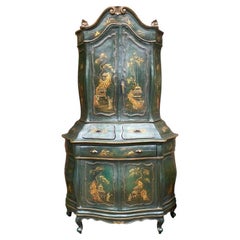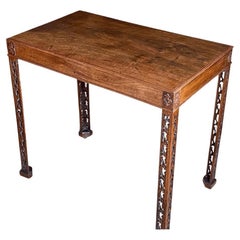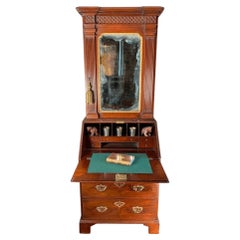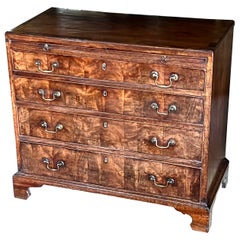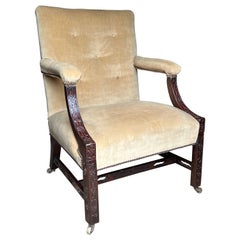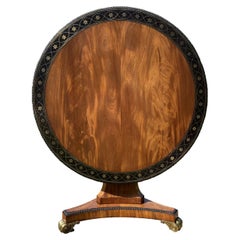Box House Antiques Ltd.
to
64
54
17
15
12
11
10
9
5
3
3
3
3
3
2
2
2
2
2
1
1
1
1
1
1
1
1
1
19th Century Venetian Rococo Lacquer Cabinet
Located in Lymington, GB
An antique Venetian rococo japanned (or 'lacquer') cabinet.
This rare and sophisticated antique cabinet separates in two, with bombé and serpentine profiles.
The particularly fine ...
Category
Antique Mid-18th Century Italian Rococo Cabinets
Materials
Lacquer
Fine Chippendale Period Carved Silver Table, circa 1760
Located in Lymington, GB
A fine English Chippendale-period silver table. George III.
This is a particularly refined and beautifully-controlled version of a mid-18th century mahogany silver table. Raised on ...
Category
Antique Mid-18th Century English George III Sofa Tables
Materials
Mahogany
Small Size Mid-18th Century Mahogany Bureau Bookcase or Cabinet
Located in Lymington, GB
A small-sized mid-18th century mahogany bureau bookcase / cabinet.
George II-period, ca 1740.
This diminutive Georgian bureau bookcase – als...
Category
Antique 18th Century English George II Bookcases
Materials
Mahogany
Rare George III Walnut and Mahogany Caddy-Top Bachelor’s Chest
Located in Lymington, GB
An English George III-period walnut and mahogany caddy-top bachelor’s chest. Mid-eighteenth century, ca 1760.
This is a superb quality bachelor chest with slide, in a rare combination of well-figured walnut and mahogany of deep, rich colour.
Containing four graduated cockbeaded working drawers, unusually faced with veneers, rather than in the usual solid.
Of fine colour, patina and excellent proportions. Raised on the original bracket feet and retaining its original brass swan-neck handles. In excellent condition throughout. Sophisticated, very useful and smart.
A chic antique.
W 36” (95 cm)
D 19” (48 cm)
H 32 3/4’’ (83 cm).
Literature:
A. Hepplewhite and Co. 'The Cabinet Maker and Upholsterer's Guide 1788', plate 75 ''Dressing Drawers...
Category
Antique 1760s English George III Commodes and Chests of Drawers
Materials
Mahogany, Walnut
18th Century Chinese Chippendale Mahogany Gainsborough Library Armchair
Located in Lymington, GB
A very good Chippendale-period mahogany Gainsborough armchair, circa 1760.
This is a lovely example of an early-George III Gainsborough library armchair in the sophisticated Chinese taste of the period.
With well-executed blind-fret carving to the square legs and arm supports.
Note the unusual treatment of the gently-outswept padded arms. Furthermore there is subtle shaping to the top of the back.
The 'H' stretcher with pierced Gothick carving.
Professionally upholstered to a high standard and overstuffed in a neutral soft velvet, with float buttons and close nailed. Raised on old brass castors. Lovely, rich, old colour and patina. In excellent condition with a sturdy frame throughout.
These Georgian library armchairs are sometimes also known as Martha Washington chairs...
Category
Antique Mid-18th Century English George III Armchairs
Materials
Mahogany
Fine Regency Mahogany Library Centre Table
Located in Lymington, GB
A fine Regency-period tilt-top brass inlaid mahogany and calamander library center table.
Raised on a concave-sided triform base, with well-modelled cast-brass scrolling feet.
Also referred to as a monopodium (table).
All in excellent condition, well figured, and of very good rich color.
Typical of designs by Thomas Hope (1769 - 1831).
This form of antique table is also associated with work by George Bullock (1777 - 1818) and George Oakley (circa 1765 - 1841).
Refs:
A similar table with a leather insert, in the manner of Thomas Hope, circa 1800 - 1805, was sold in London for £39,650 - December 2010.
This early 19th century table is reminiscent of the ‘Grecian’ style that the pioneering collector and designer Thomas Hope (1769-1831) popularized in Britain with the publication of ‘Household Furniture and Interior Decoration’ in 1807.
Thos. Hope (banker, born 1769, d. 1831)
The furniture manufacturer George Oakley (circa 1765-1841) was greatly influenced by Hope’s designs, and produced fashionable furniture in this style, using brass and star inlays similar to our table on offer. The firm’s designs and craftsmanship earned them royal patronage, and Oakley worked for the Prince Regent at Carlton House, as well as supplying furniture and upholstery for The Mansion House and The Bank of England. His work for the Cheere family - of Papworth Hall, Cambridgeshire, UK - is well documented.
The reference to Geo. Oakley relates to a known table of this pattern in calamander wood and brass marquetry of starred-ribbon guilloche, which corresponds to the brass marquetry in a table supplied by Oakley in 1810 to Papworth Hall.
Literature:
Parker, R. 'History of Papworth Everard...
Category
Antique Early 1800s English Regency Center Tables
Materials
Mahogany
Very Rare Carved Gilt Gesso Dressing Mirror, circa 1710-1720
Located in Lymington, GB
A very rare carved gilt gesso dressing mirror. Queen Anne / George I-period, ca 1710-20.
Decorated all over with the original finely carved gilt-gesso surfaces with typical circular punched reserves.
The hinged fall - of what one might refer to as the 'table bureau' section - reveals a shaped, fitted interior, gilded and japanned (''lacquered'') in black with red.
Some external carved surfaces show very minor areas of wear revealing the authentic bole and gesso ground. Overall in superb condition.
H: 39 1/2’’ (100 cm)
D: 12 1/2’’ (31.5 cm)
W: 17 3/4’’ (45.5 cm).
Reminiscent of the work of London-based James Moore (ca 1670-1726), a supreme exponent of the art of cut gesso and gilding.
This dressing table mirror is possibly unique in this form, and as such has survived some 310 years in remarkably original state.
It may have been part of a suite of furniture, would have been extremely costly, and very much the reserve of the aristocracy and wealthy in the early part of the 18th century.
For documented pieces by James Moore visit the Royal Collection Trust.
Wikipedia: James Moore (furniture designer).
James Moore (circa 1670 - October 1726) was established at Short's Gardens, St. Giles-in-the-Fields. He was in partnership with John Gumley from 1714 and, unlike his partner, did not advertise - the sole published reference to him being a notice of his death in The Weekly Journal or The British Gazetteer. As Royal cabinet-maker he supplied walnut and mahogany furniture for the Royal Household, the Royal Yacht, and the King's servants and mistresses, as well as the rich gilt-gesso work for which he is best known.
Moore is especially renowned for gilt-gesso furniture: tables; looking glass frames; and candle stands. A pair of gilt-gesso side tables bearing the crowned cypher of George I in The Royal Collection, and the pair of candle stands en-suite are incised with his name - an unusual practice at the time. At Erddig, such furniture by Moore can be linked to surviving bills and receipts from James Moore and John Belchier, 1722-26.
Gilt-gesso furniture is also encountered in fine Louis XIV and other European furniture of the period.
Literature:
Ralph Edwards CBE FSA 'The Shorter Dictionary of English Furniture', Hamlyn, London (Fourth Impression 1972) ill. 5, p. 363. One of a pair of looking glasses by James Moore, 1720. Erddig, Denbigh. The crest is reminiscent of that upon our dressing mirror, which we are offering here.
Kreisel, Heinrich, 'Die Kunst Des Deutschen Mobels', CH Beck, Munchen (1970) ill. 345, p. 347 - note similarities in the treatment of the top of the crest. This mirror was last seen in the collection of Augsburg Castle.
Synge, Lanto, 'Great English Furniture', London (1991) p. 52.
Symonds, R. W., 'A Royal Scrutoire', Connoisseur (June 1940) pp. 233-236.
Symonds, R. W., 'English Gesso Furniture', The Antique Collector, Vol. XXVII (August 1956) p. 140.
'A Golden Cabinet...
Category
Antique Early 18th Century English Queen Anne Table Mirrors
Materials
Giltwood
Fine Gillows George III Period Satinwood Secretaire Cabinet
Located in Lymington, GB
An exceptional English Sheraton-period satinwood secretaire cabinet. Attributed to Gillows.
Late-18th century, George III, ca 1790.
Measures:
H 59 1/2’’ (151 cm)
W 30’’ (76 cm)
D 19’’ (49 cm).
This small, beautifully-proportioned, and sophisticated antique writing cabinet...
Category
Antique Late 18th Century English George III Secretaires
Materials
Satinwood
Queen Anne Walnut Double Dome Bookcase Cabinet
Located in Lymington, GB
A Queen Anne-period walnut veneered & featherbanded double-dome bookcase or cabinet of good rich colour.
The two door mirrored upper section surmounted b...
Category
Antique 1710s English Queen Anne Cabinets
Materials
Walnut
$24,775 / item
Pair Regency Period Bronzed Giltwood Torchères
Located in Lymington, GB
A fine and rare pair of English Regency period torchères, or stands (or candle stands) in the manner of Thomas Hope. Circa 1810.
Both are raised on tapering simulated-bronze column supports with circular tops and fluted gilt collars, on concave-sided triform bases with winged-panther mask monopodia. The column bases issue from spreading, gilded, carved lotuses.
These antique torcheres might also be referred to as columns, ornamental stands, candle sticks, or candelabra.
In superb condition throughout.
Literature:
‘Thomas Hope – Regency Designer’ ed. David Watkin & Philip Hewat-Jaboor, Yale University Press, New Haven and London (2008).
The Aurora Room, Duchess Street, photo from V & A Museum, fig. 68-1, p. 378.
The Royal Collection, HM Queen Elizabeth II, RCIN 588- 1-2, 45- 1-2, figs. 78-2, 78-3, p. 396.
The Faringdon Collection, Buscot Park, Oxfordshire, illustr. 88, p. 414.
The pair of stands we are offering here correspond closely to the pair in the Faringdon Collection (see above). Watkin and Hewat-Jaboor state; ‘’A ‘Roman’ stand of this precise design, perhaps an imaginative variation on one published by Visconti*, is illustrated in ‘Household Furniture’, plate L, number 2… Hope also owned several classical Roman candelabra...
Category
Antique Early 19th Century English Regency Candlesticks
Materials
Giltwood
$38,539 / set
Rare Fine 18th Century China Trade Carved Padouk Tripod
Located in Lymington, GB
A very rare and finely-carved China trade padouk tripod table. Canton, circa 1750-1760.
Wonderful carving to the base, and a most unusual bold border to the top.
Its outstanding idi...
Category
Antique 18th Century Chinese Chippendale Tables
Materials
Padouk
A Fine Old & Ody George I Burr Walnut Secretaire Cabinet
Located in Lymington, GB
A fine English George I-period burr (burl) walnut secretaire cabinet attributed to Old & Ody.
Early-18th century, ca 1720.
The top section separates from the base and opens to reveal numerous fitted drawers, behind doors with original bevelled arched mirror plates.
The base contains a fall-front fitted secretaire with small drawers, two of which have secret drawers. Engraved mounts are contemporary if not original. All locks and cross-grained mouldings are original.
Beautiful deep rich colour throughout, with superb matched burr veneers within herringbone lines.
Bun feet are original. Lined throughout in best-quality English oak.
The well patinated, green, gilt-tooled liner in the writing surface appears original. In excellent condition overall.
Very much in the style of John Old & William Ody.
One of the most original early-18th century pieces of English walnut cabinet...
Category
Antique 18th Century English George I Cabinets
Materials
Walnut
Exceptional Regency Bonheur Du Jour Attributed to John Maclean
Located in Lymington, GB
An exceptional English Regency-period bonheur du jour attributed to John Maclean, ca 1810.
A fine early-19th century rosewood and brass-inlaid bonheur du...
Category
Antique Early 19th Century English Regency Desks
Materials
Rosewood
George III Serpentine Inlaid Writing Dressing Table
By Pierre Langlois
Located in Lymington, GB
A George III-period sabicu and goncalo alves serpentine writing / dressing table. In the manner of master cabinet-maker Pierre Langlois, circa 1770.
Gr...
Category
Antique 1770s English Tables
Materials
Wood
Large Carved Stone Rhino Sculpture
Located in Lymington, GB
An impressive, life-like, well-carved solid stone statue (or sculpture) of a rhinoceros.
20th century.
Measures:
L 66 cm (26")
H 31 cm (12 1/4")
W 22 cm (8 1/2").
Category
20th Century European Animal Sculptures
Materials
Stone
Early 18th Century Walnut Wing Chair
Located in Lymington, GB
An early-18th century walnut wing armchair. Queen Anne/ George I-period, ca 1714.
This fine English walnut wingback chair is raised on well-drawn carved cabriole legs. With a lovely kick on the back legs.
Remarkably, after some 310 years, it still retains its original gros-point needlework upholstery in vibrant colors.
Of superb proportions, color, figuring and patination.
Measures:
H 106 cm (42'')
D 68 cm (27'').
W 87.5 cm (34 1/2'').
Seat H: 42.5 cm. (16 3/4'').
Literature:
Herbert Cescinsky 'English Furniture Of The Eighteenth Century', George Routledge & Sons (1911) vol. I, p. 81, fig. 105. ''A walnut easy chair'' dated 1710.
Nb. A slightly earlier antique walnut and beech wing armchair with contemporary needlework, circa 1710, sold in Christies, Lot 164, October 2015 @ £48,350 -The Property of the Metropolitan Museum of Art.
Sothebys sold a George II needlework...
Category
Antique Early 18th Century English Georgian Wingback Chairs
Materials
Walnut
George II Red Walnut Stool
Located in Lymington, GB
A good quality George II-period Virginia (or 'red') walnut stool with a shaped apron.
Mid-18th century, circa 1750.
Excellent overall color and patination.
The rising top close-nail...
Category
Antique 1750s English George II Stools
Materials
Walnut
George III Period Mahogany Partner's Desk, circa 1800
Located in Lymington, GB
A fine George III-period mahogany partner’s desk, circa 1800.
This is a very good quality Georgian English partner’s desk of classic proportions.
Excellent deep, rich color and pati...
Category
Antique Early 1800s English George III Desks and Writing Tables
Materials
Mahogany
George III Period Satinwood Pembroke Table
Located in Lymington, GB
A late 18th century satinwood Pembroke table of very good rich color.
George III period.
The top crossbanded in satinwood, bordered with fine lozenges of ebony stringing.
The edges ebonized with narrow mahogany crossbandings.
Raised on moulded tapering legs, indicative of a date circa 1770.
The frieze with two working mahogany-lined short drawers retaining the original gilt-brass Rococo mounts.
The two leaves are supported on the original recessed hinged ‘ear’ supports.
Overall in lovely original state. Some minor historic marks entirely commensurate with its age. Very good patination.
These antique Pembroke tables were designed to be versatile: as small supper tables; occasional tables; tea tables; or lamp tables - sometimes also referred to as ‘drop leaf’ or ‘sofa’ tables.
The majority of these Georgian tables are raised on square tapering legs or, when of a later date, on turned legs. It is more unusual for a satinwood Pembroke table to be raised on moulded tapering legs.
Interestingly, Thomas Sheraton (1751-1806) mentions the Pembroke table as follows: “a type of breakfast table from the name of the lady who first gave orders for one of them”, possibly referring to the Countess of Pembroke, of Wilton House, Salisbury, (1737-1831).
A similar George III satinwood Pembroke table...
Category
Antique 1770s English Tables
Materials
Satinwood
Charles II Oak and Walnut Chest of Drawers
Located in Lymington, GB
Charles II period (1630-1685) oak and walnut chest of drawers, or commode.
Retaining old waxed surfaces of very good rich color and patination.
With typical geometric drawer fronts and side runners, confirming a late 17th century date of c 1680.
Walnut panel inserts to the drawer fronts.
Retains its original stile feet and the base with its original bold moulding.
Brass key escutcheons...
Category
Antique 1680s English Charles II Commodes and Chests of Drawers
Materials
Oak, Walnut
George II Mahogany Wine Waiter or Bottle Carrier
Located in Lymington, GB
A rare English mahogany wine waiter or bottle carrier / stand. Of superb colour and patination.
Mid-18th century, late George II period, circa 1750-1760.
This fine, larger-than-usual, Georgian example retains its original lion mask gilt-brass mounts, and has survived with its original fretted angles.
Rare to find in this excellent condition in view of the considerable use to which it would have put been during the last 265 or so years.
These scarce open-topped Chippendale period wine waiters serve as bottle carriers raised on legs, with brass castors. They were designed to allow bottles to be circulated around a dining room for guests to help themselves. They had divisions, separated from their stands, and also had a central arched-shaped carrying handle.
When not-in-use these wine waiters, or wine wagons...
Category
Antique 1750s English Wine Coolers
Materials
Mahogany
Pair of Empire Style Window Seats
Located in Lymington, GB
A smart pair of Empire-style window seats of superb quality, and in excellent condition.
Supported on stained-oak tapering square legs with gilt-brass mounts and hairy paw feet.
Upholstered and buttoned in faded vellum-green hide...
Category
20th Century Empire Chairs
Materials
Wood
$4,101 / set
George III Mahogany Bachelor's Chest
Located in Lymington, GB
A George III-period mahogany bachelor's chest with caddy top. Late-18th century, circa 1780.
With four graduated cockbeaded drawers and a pull-out slide.
Raised on its original bracket feet.
Nb. This has the unusual feature of a caddy top.
Retaining its original brass swan-neck handles, locks and key escutcheons.
This very useful Georgian bachelor, or bachelor's, chest was designed with a pull-out slide for ironing and folding clothes...
Category
Antique Late 18th Century English George III Commodes and Chests of Drawers
Materials
Mahogany
Rare George II Walnut Caddy Top Chest
Located in Lymington, GB
A rare, small English George II-period walnut caddy-top chest. Only 2’7'' wide.
Mid-18th century. Circa 1740-1760.
W 31'' (78.74 cm)
H 31 1/2'' (80.01 ...
Category
Antique Mid-18th Century English George II Furniture
Materials
Walnut
